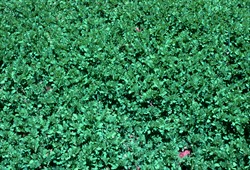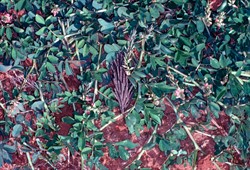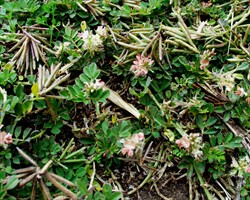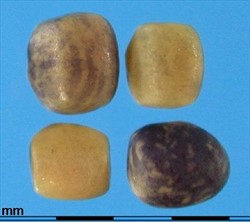Indigofera spicata
Tropical Forages
Indigofera spicata Forssk.
Note: There is considerable confusion in the literature between Indigofera spicata Forssk. and Indigofera hendecaphylla Jacq., which were initially considered synonyms, but since 1993 they have been treated as separate species (du Puy et al., 1993). This leads to difficulties in ascribing effects attributed to Indigofera spicata pre 1993 and in more recent literature, to either species, particularly in relation to toxicity.
Indigofera spicata Forssk. No synonyms listed in GRIN.
Indigofera hendecaphylla Jacq.: Indigofera endecaphylla Jacq. ex Poir., orth. var.; Indigofera neglecta N.E. Br.; Indigofera spicata auct., pro parte majore (used in the sense of subsequent authors, for the greater part).
Family: Fabaceae (alt. Leguminosae) subfamily: Faboideae tribe: Indigofereae subsection: Alternifoliolae.
Prostrate to weakly ascending, spreading, perennial herb, to 0.5 m high, and 1 m across, with strong, deep, woody taproot and low to submerged crown; young stems ridged (flattened when young), green or yellowish, strigose with sparse, hyaline to white appressed, equally biramous hairs; older stems brown, sometimes rooting at the nodes. Leaves alternate, 1.2–4 cm long, pinnate, (3–) 5–7 leaflets inserted alternately; stipules triangular (2.5–) 3.5–5.5 (–6.5) mm long, with scarious margins, glabrescent, not spinescent, persistent; petiole 2–6 mm long; rachis furrowed. Leaflets obovate, (3–) 4–11 (–16) mm long, 2.5–8 (–10) mm wide; upper surface glabrous or with sparse, appressed hairs; lower surface with sparse to moderately dense, appressed hairs; apex obtuse (with short mucro); veins not prominent; stipellae absent or inconspicuous, 0.2–1.2 mm long, membranous, some dividing into 2 or 3 segments. Inflorescence a spike-like raceme, 30–65 (–80) mm long; peduncle 15–20 (–25) mm long; bracts triangular (margin scarious), 1.2–2 mm long; flowers pink to orange-red, sometimes white; pedicel 0.3–0.7 mm long; calyx 2–3 mm long; lobes sub-equal, longer than the length of the tube and covered with sparse to moderately dense, white, appressed hairs; standard reddish, sometimes white, obovate, 3.8–4.9 mm long, 2.5–3.7 mm wide; hairs sparse (few at apex only), hyaline to white; apex obtuse; wings oblong to spathulate, 3.7–4.5 mm long, 0.5–1.1 mm wide; keel 3.9–4.4 mm long, 1–1.3 mm deep, lateral pockets 0.3–0.5 mm long; apex acute; glabrous or with sparse, hyaline hairs at the tip; staminal tube 2.3–3.2 mm long, colourless; ovary moderately to densely hairy. Pod descending, terete (often torulose when young), 10–18 mm long, 1.5–2 mm wide, yellowish and brown, strigose to glabrescent; hairs sparse, appressed; apex shortly pointed (to 0.5 mm long); endocarp not spotted; seeds cuboid, 4–8 per fruit, 1.3–1.6 mm long, 1–1.4 mm wide; 480,000–830,000 seeds/kg, depending on provenance.
Similar species
I. spicata: leaves 1.2–4 cm long, leaflets (3–) 5–7 (–8), obovate, base cuneate; inflorescence 3–8 cm long; staminal tube 2.3–3.2 mm long, not exceeding the calyx, keel apex acute; pod 10–18 mm long including short, blunt tip 0.5 mm long.
I. hendecaphylla: leaves 2.5–7.5 cm long, leaflets (7–) 9–11, narrowly oblong-elliptical to narrowly oblanceolate; inflorescence 5–16 cm long; staminal tube 4–5 mm long, distinctly larger than the calyx, keel apex rounded to obtuse; pod 22–27 mm long, including distinct beak 1.5–2.5 mm long.
Africa: tumba-djali (Angola); agoman (Benin); n'gara (Guinea); dawa-le nkop, hiri, musuusuu, olando (Kenya); emuchukuchuku, hiri, kipande, myata (Tanzania); kibwankurata (Uganda)
Asia: 穗花木藍 sui xu mu lan (China); cherru-pulladi (India); basingan; baleh angin (Sulawesi); sibar (Sumatra) (Indonesia); Afurika-koma-tsunagi (Japan); khram-khrua (Thailand); cây đậu chàm, chàm bò, chàm bông, chàm gié, đậu tràm (Vietnam); mscheter, m’scheter, musaytir, schiter (Yemen)
English: creeping indigo, lawn indigo, prostrate indigo, red nerinjy, spicate indigo, trailing indigo
Europe: indigo rampant; indigotier en épi (Réunion) (French); kriechender Indigostrauch (German)
Pacific: `iniko, `inikoa, kolu (Hawaii)
Madagascar: aika, anky, egitra, engitra, famafatsambo, sindahoripotsy
Latin America: amendoim-bravo (Brazil); añil rastrero (Puerto Rico)
Note: Many of the common names listed, particularly those from Asian countries, may well refer to the very similar species, Indigofera hendecaphylla Jacq., that is native to subtropical and tropical Asia as well as to Africa.
Native:
Africa: Burkina Faso; Burundi; Cameroon; Central African Republic; Democratic Republic of the Congo; Ethiopia; Kenya; Malawi; Mozambique; Rwanda; South Africa (KwaZulu-Natal, Transvaal); Sudan; Tanzania; Uganda; Zambia; Zimbabwe
Indian Ocean: Madagascar; Mauritius
Arabian Peninsula: Yemen (S)
The endemic range of I. spicata is much more restricted than that of I. hendecaphylla, which extends into Asia. Since it is not possible to individualise some of the reported characteristics for the two species, much of the information here will relate to the Indigofera spicata-hendecaphylla complex.
Naturalized:
Widely naturalized in other parts of the tropics and subtropics.
Forage
Mainly planted for cover, green manure and erosion control in coffee, tea and rubber plantations in the tropics and subtropics. It occurs in natural pasture, but has not been sown as forage.
Environment
Planted as ground cover, green manure, and erosion control in coffee, tea, and rubber plantations in warm parts of the Old World.
Other
Minor source of indigo dye.
Soil requirements
Best adapted to dark clay and clay loam soils of pH 5.0–7.7, but also found on sandy soils, and soils with pH as low as 4.0 and as high as 8.5. Tolerant of low soil P status.
Moisture
Mostly found in areas with average annual rainfall of 600–1,500 mm, but up to 4,000 mm. Annual rainfall in collection areas in Yemen is as low as 200 mm, although these were edges of drainage lines. I. spicata appears to extend the distribution of the complex into lower rainfall areas, but is still found in higher rainfall areas.
Temperature
While primarily a warm season species complex, it is widely adapted, being found in areas of the lowland tropics and subtropics, and upland tropics (to 2,800 m asl at Quito in Ecuador). 24 hour average annual temperatures range from 13 to 27 °C.
Light
Found mostly in open grassland, but used as ground cover/green manure in plantation crops, suggesting preference for full light, but tolerance of at least light shade.
Reproductive development
I. spicata commences flowering in late summer/early autumn and fruiting in early/mid-autumn.
Defoliation
Extremely tolerant of regular low defoliation, becoming a weed in turf.
Fire
No information, but probably tolerant of fire by virtue of the very low or submerged crown.
Establishment
I. spicata often has high levels of hard seed, but these can be broken down with mechanical or hot water scarification. Care should be taken with some hot water treatments that can also kill previously germinable seed. I. spicata will in most cases nodulate effectively on native rhizobia, but seed can be inoculated with Bradyrhizobium strains such as 210407 (Japan) or CB 756 (Australia). Being a small seed, it should be sown no deeper than about 1 cm.
Fertilizer
In the absence of empirical information, it is probably appropriate to treat I. spicata like other moderate fertility legume species such as Macroptilium atropurpureum. On soils with less than about 8 ppm available phosphorus, 20–30 kg/ha P may be required at establishment, and 10– 20 kg/ha/yr P for maintenance. The need for other nutrients, particularly K and S, should be monitored by soil analysis or foliar deficiency symptoms. Molybdenum may be required at 100 g/ha Mo at establishment on deficient soils, and 100 g/ha Mo every 4–5 years as maintenance, particularly on more acid soils.
Compatibility (with other species)
Commonly found in association with lower growing and sward-forming grasses and legumes.
Companion species
Grasses: Axonopus fissifolius, Cynodon dactylon, Digitaria didactyla, Paspalum notatum, Stenotaphrum dimidiatum.
Legumes: Chamaecrista rotundifolia, Grona triflora, Stylosanthes humilis.
Pests and diseases
Very few pests and diseases of any consequence. Okra mosaic virus (OMV, tymovirus group) has been isolated from Indigofera spicata in Nigeria.
Ability to spread
Spreads readily due to prolific seed production, and ready establishment in disturbed situations, including heavily defoliated swards.
Weed potential
Most references to weed threat relate to toxicity (see Feeding value). It is rarely a weed in crops, but is a common weed of turf in some regions.
Nutritive value
Analyses of material from lines listed as I. spicata, but probably predominantly I. hendecaphylla, show CP levels as high as 23% and NDFvalues as low as 32%.
Palatability/acceptability
I. spicata and I. hendecaphylla are both highly palatable to most classes of livestock.
Toxicity
In the absence of conclusive exonerating data, all Indigofera species should be treated with caution in developing livestock feeding systems due to the presence of the toxic, non-proteinogenic amino acid, indospicine (2,7-diamino-7-amino-heptanoic acid), in leaves and seeds of some species. Initially identified in the I. spicata complex that has lent its name to the amino acid, indospicine is highly toxic to chickens, rabbits, pigs, goats, sheep, cattle and horses, and because it accumulates in the tissues, to susceptible animals (e.g. dogs) eating the flesh of these species. It causes loss of vitality and abortion in sheep, goats and cattle, liver damage in sheep, cattle and rabbits, and death in horses and chickens. Another toxic substance, 3-nitropropionate (3-NPA), has been isolated from I. spicata, which causes a range of largely irreversible neurological symptoms in the grazing animal. There is evidence from other Indigofera spp. that indospicine levels vary with seasonal conditions. While it has been reported that some African diploid strains are non-toxic, attempts at breeding very low mimosine varieties have so far been unsuccessful.
Feedipedia link
Dry matter
While no yield data could be found for I. spicata, its more robust relative, I. hendecaphylla, has produced yields up to 5 t/ha green matter after 2 months and 25 t/ha after 6 months. As with most low-growing species, yield data would be greatly influenced by height and frequency of harvest.
Animal production
Due to the toxic nature of the species, it would be assumed that long-term effects would be negative. It is for this reason that I. spicata has been largely avoided in pasture legume evaluation programs.
Nevertheless, while it is clear that both species contain or are even dominated by toxic provenances, there is sufficient agronomic merit in the complex to warrant more definitive study to select for low toxicity in this potentially valuable forage legume. Rusa deer in Mauritius graze native I. spicata-dominant pastures at certain times of year, with apparently no ill effect.
2n =32. Again there is confusion on the basis of true species identity.
No information available.
I. spicata is not readily killed with simple herbicide applications that might kill tops but a high proportion of plants recover. Commercial broad spectrum compound herbicides comprising aminopyralid and 2,4-D amine or aminopyralid and metsulfuron methyl have given good control.
- Drought tolerant.
- Nitrogen-fixing legume.
- Adapted to wide range of soil types and conditions.
- Tolerant of heavy grazing.
- Toxicity.
- Paucity of information.
Aylward, J.H., Court, R.D., Haydock, K.P., Strickland, R.W. and Hegarty, M.P. (1987) Indigofera species with agronomic potential in the tropics. Rat toxicity studies. Australian Journal of Agricultural Research 38:177–186. doi.org/10.1071/AR9870177
Christie, G.S., Wilson, M. and Hegarty, M.P. (1975) Effects on the liver in the rat of ingestion of Indigofera spicata, a legume containing an inhibitor of arginine metabolism. The Journal of Pathology 117:195–205. doi.org/10.1002/path.1711170402
Du Puy, D.J., Labat, J.N. and Scrire, B.D. (1993) The separation of two previously confused species in the Indigofera spicata complex (Leguminosae: Papilionoideae) Kew Bulletin 48:727–733. http://doi.org/10.2307/4118850
Fletcher, M.T., Al Jassim, R.A.M. and Cawdell-Smith, A.J. (2015) The occurence and toxicity of indospicine to grazing animals. Agriculture 53:427–440. doi.org/10.3390/agriculture5030427
Frahm-Leliveld, J.A. (1960) Observations on chromosomes in the genus Indigofera L. Acta Botanica Neerlandica 9:286–293. doi.org/10.1111/j.1438-8677.1960.tb00658.x
Hutton, E.M. and Guerassimoff, J. (1966) Problems in breeding the legume Indigofera spicata for tropical pastures. Euphytica 15:353–361. doi.org/10.1007/BF00022179
Kelly, W.R., Young, M.P., Hegarty, M.P. and Simpson, G.D. (1992) The hepatotoxicity of indospicine in dogs. In: James, L.F., Keeler, R.F., Bailey Jr, E.M., Cheeke, P.R. and Hegarty, M.P. (eds) Poisonous plants: Proceedings of the third international symposium. Iowa State University Press, Ames, IA, USA. p. 126–130.
Strickland, R.W, Lambourne, L.J. and Ratcliffe, D. (1986) The palatability, feeding value and apparent toxicity of 150 legume species fed to rats. Genetic Resources Communication No. 10. CSIRO Tropical Agriculture, St Lucia, Australia. bit.ly/33YYCUX
Strickland, R.W., Lambourne, L.J. and Ratcliff, D. (1987) A rat bioassay for screening tropical legume forages and seeds for palatability and toxicity. Australian Journal of Experimental Agriculture 27:45–53. doi.org/10.1071/EA9870045
Sunarno, B. (1997) Indigofera hendecaphylla Jacq. In: Faridah Hanum, I. and van der Maesen, L.J.G. (eds) Plant Resources of South-East Asia No. 11. Auxiliary Plants. Backhuys Publishers, Leiden, the Netherlands. p. 123‒127. edepot.wur.nl/411331
None released.
None reported.








